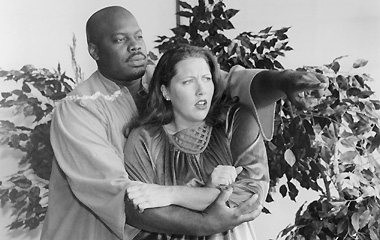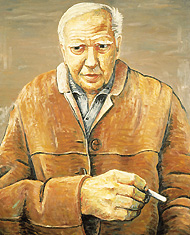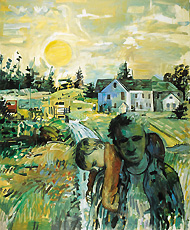![]()
Departments
Arts
![]()

|
Week of 22 October 1999 |
Vol. III, No. 11 |
Arts
|
|
|
Philip Guston with Overcoat,
1982, oil on canvas, 66" x 54"
|
By Eric McHenry
Many artists and former studnts remember Philip Guston for his puckish, almost pranksterish, approach to painting. But in the recollections of Jon Imber, a Guston protege and one of Boston's most esteemed expressionists, the method is as prominent as the madness. Guston's fun, Imber says, was serious fun.
"One of the most important things he taught me about art was what a hard endeavor it is," says Imber (SFA'77), whose works are on display through December 5 in the Boston University 808 Gallery. "I'd ask him, 'Does it ever get easier?' 'No,' he'd say, 'it always gets harder.' His message was: if you think it's difficult now, just wait until you're my age."
Not exactly words that inspire. But for Imber, Guston was decidedly an inspiration. The notes of caution he sometimes sounded were just what an emerging artist needed.
"He reinforced in me everything that's appropriate to reinforce in a younger painter &emdash; enthusiasm, patience, perseverance, and the importance of past masters," says Imber, who studied with Guston at SFA from 1975 to 1977. "I loved every minute I spent with him, and I learned more in an hour with him than I learned in four years of undergraduate school."
Among other things, Imber inherited from Guston a belief in the importance of taking chances and being open to change. As a result, his work of the past 20 years has moved across spectra of both subject matter and style. Every significant phase in its evolution is represented in the 808 exhibition The World as Mirror: Paintings by Jon Imber, 1978&endash;1998.
"Guston set a fine example for Imber," says John Stomberg, director of the BU Art Gallery and curator of the 808 show. "He was a well-regarded figural painter in the '30s, and he changed styles, as so many of them did, to become a leading abstract expressionist.
|
|
|
Afternoon on Eagle Island, 1998,
oil on canvas, 72" x 60"
|
The earliest paintings in The World as Mirror bear the stamp of Imber's principal influences &emdash; Guston and Max Beckmann. Imber started out, he says, producing "almost simplistic figurative paintings."
"Then I got restless," he says, "and moved into portrait painting &emdash; large, realistic heads, done from mirrors and photographs. I actually started with three portraits of Guston, and that led to two years of doing portraits that were fairly, although never slavishly, realistic."
Beginning in 1985, Imber enjoyed several productive years painting landscapes. Then, in the early '90s, he rented a studio in Stonington, Maine, that overlooked piers. "Before I knew it," he says, "I was painting still lifes of ropes and toggles and buoys."
Those still lifes, in turn, "evolved into almost abstract, cubist paintings. And just as soon as I was getting really good at them, my son, Gabriel, was born," he says.
The new arrival, in 1994, heralded yet another significant change of artistic direction for Imber. Suddenly, he had to complete his day's painting inside of three hours and outside of the house. In the past he had composed landscapes in the studio, working from sketches. Now he began to explore plein air: taking a 20" by 30" panel outside with him and painting what he saw.
Imber's wife, Jill Hoy, is "a very dedicated painter as well," he says, "and she didn't want to give up her painting time any more than I did. So we've shared in bringing up Gabriel. Of course, half-time with a two-year-old is really a full-time job. But being outside and having to paint quickly has turned out to be a good way of keeping my work moving."
The plein air landscapes feature prominently in a concurrent exhibition of Imber's work, which will run through November 13 in the Nielson Gallery, 179 Newbury St., Boston. Made up entirely of paintings from the past year, it serves as a sort of epilogue to the midcareer retrospective at BU.
Landscapes aren't the only subjects Imber has revisited as a result of his son's birth. "I've also painted Gabriel quite a bit over the past five years," he says. "And that, in some ways, has reinvigorated my urge to be a figurative painter."
Imber's willingness to move forward, it seems, has brought him full circle.
Jon Imber will introduce The World as Mirror with a gallery talk at 5 p.m. on Friday, October 22, in the Boston University 808 Gallery, 808 Commonwealth Ave. An opening reception will follow. For more information, call 617-353-3329.
Opera Fringe Festival

The SFA Opera Institute will present Béla Bartók's mysterious masterwork Bluebeard's Castle, Friday, October 22, through Sunday, October 24, in the Boston University Theatre's Studio 210. Morris Robinson (SFA'01) and Colleen Firstenberger (SFA'00) (pictured) will alternate the roles of the Bluebeard and his doomed bride with Steven Humes (SFA'00) and Heejea Im (SFA'01). Admission is $5 for the general public and free for students. The Opera Institute Fringe Festival, a series of one-act operas and open forum discussions with guest directors, artists, and composers, will run through November 7. For tickets and information, call 353-5201. Photo by Vernon Doucette

